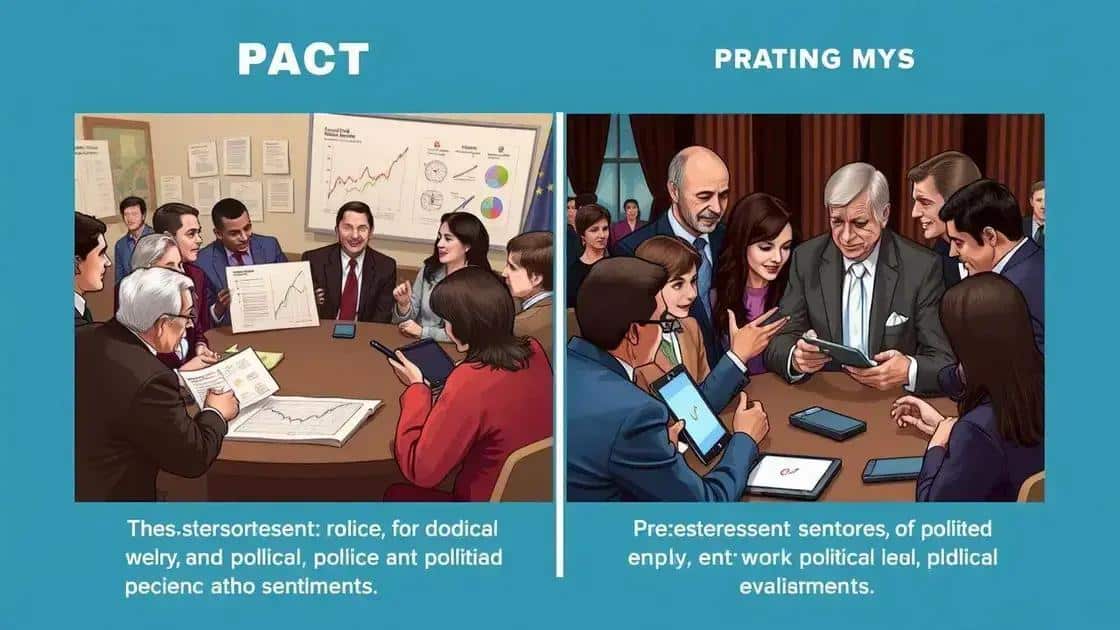Polls reveal shifting public opinion against Trump’s policy proposals

Anúncios
Polls reveal shifting public opinion against Trump’s policy proposals, with media influence and demographic changes playing key roles in shaping perceptions and potential future policy directions.
Polls reveal shifting public opinion against Trump’s policy proposals, and it’s a topic that’s gaining traction. Have you noticed how opinions are evolving as new data comes to light? Let’s explore this intriguing shift together.
Anúncios
Understanding the latest polling data
Understanding the latest polling data is essential to grasp how opinions are shifting. Recent surveys reveal that public sentiment towards Trump’s policy proposals is increasingly negative. This transformation underscores the importance of analyzing how these shifts occur and what factors contribute to them.
The significance of polling data
Polling data serves as a valuable tool for policymakers and the public alike. It helps to track the mood of the electorate and provides insight into emerging trends. By examining the intricacies of these polls, we can glean essential details about public preferences. This understanding can be critical for future electoral strategies.
Key factors affecting polls
- Current events: Major news stories often influence public opinion.
- Social media: Platforms shape how individuals perceive issues.
- Demographics: Different groups may respond uniquely based on age, race, and gender.
- Political climate: The overall sentiment can change based on political actions and rhetoric.
In terms of methodology, different polling organizations utilize various techniques to gather data, such as phone interviews, online surveys, and focus groups. Each method comes with its own strengths and challenges. For instance, online surveys tend to reach a younger demographic, while phone interviews might better capture older voters’ perspectives. Furthermore, it’s important to consider sample size and margin of error to ensure the reliability of the data.
Anúncios
These elements combined provide a clearer picture of how public opinion is changing. Maintaining a keen eye on these fluctuations offers valuable insights into the electoral landscape. By keeping track of such data, analysts, senators, and campaign managers can adapt their strategies accordingly.
Key factors influencing public opinion
Understanding the key factors influencing public opinion is critical when analyzing polls and their outcomes. Various elements shape how people feel about political initiatives, especially those proposed by Trump. Insights into these factors can provide clarity on the shifting sentiments within the electorate.
Major influences on public perception
Several aspects contribute to the change in public opinion. The first factor is the media coverage. News outlets play a significant role in shaping narratives. They can highlight or downplay issues, impacting how the public reacts to proposed policies.
Social influences
Another factor is social dynamics. Individuals often discuss political views with friends and family. These conversations can reinforce or challenge existing beliefs. Events such as protests or rallies can have a ripple effect, influencing broader perceptions.
- Peer influence: Opinions can shift based on discussions among friends.
- Social media trends: Online platforms spread ideas rapidly.
- Cultural events: Major happenings often reflect or shift public sentiment.
- Community engagement: Local actions can impact broader opinion trends.
Moreover, demographics play a crucial role. Different age groups, races, and education levels can lead to varied perspectives on policies. For example, younger voters may prioritize climate change, whereas older voters may focus on economic stability. Recognizing these demographic differences is essential in understanding the broader picture.
Lastly, the overall political climate shapes public responses. During times of economic uncertainty or social unrest, people may become more critical of existing policies. In contrast, stable situations might lead to complacency or support for current governance. This dynamic nature of public opinion makes it vital to stay updated on the factors at play.
Comparison of past and present views

Comparing past and present views on Trump’s policy proposals reveals a significant shift in public sentiment. Historical polling data shows that many ideas that were once popular among supporters are now facing scrutiny. Such changes can be attributed to various factors, including recent events and changes in societal values.
Trends over time
In earlier years, Trump’s policies received enthusiastic support from many voter segments. However, as time progressed, increasing opposition emerged. Surveys indicate that issues like immigration and economic policy, once favored, are now viewed with skepticism by a growing number of Americans.
A closer look at specific policies
For example, the original stance on immigration was met with widespread acceptance among Trump’s base. Now, polls show a rise in concerns about the social impacts and humanitarian aspects of such policies. Additionally, views on healthcare have evolved, with more people demanding accessible services rather than favoring privatized approaches.
- Immigration: Support has waned as debates grow around humanitarian issues.
- Healthcare: There’s a push towards public options reflecting broader concerns.
- Economic strategies: Increased demand for policies addressing wealth inequality.
Another layer to this comparison involves the role of social media. The rise of platforms has allowed for rapid dissemination of diverse viewpoints, contrasting sharply with the more uniform narratives of the past. This environment fosters dialogue that influences public opinion, shifting perspectives on previously accepted ideas.
Moreover, demographic changes have impacted views. As younger generations enter the electorate, their values and priorities diverge from those of older voters. This generational gap can explain fluctuations in support for certain proposals, as issues like climate change gain prominence among younger voters.
The role of media in shaping perceptions
The role of media in shaping perceptions is crucial in today’s political landscape. Media channels are powerful tools that influence how the public views Trump’s policy proposals. With various platforms available, the way these messages are conveyed can significantly impact public opinion.
The influence of traditional media
Television and newspapers have historically been the primary sources of information for voters. They craft narratives that can either bolster or challenge the president’s policies. For instance, a positive news story about the economy may strengthen support for economic policies, while critical reporting on immigration can incite backlash. This shows how the media has the ability to steer public sentiment through its coverage.
Social media’s impact
In the digital age, social media has emerged as a major player in shaping perceptions. Platforms like Twitter, Facebook, and Instagram allow for rapid sharing of information, both good and bad. They also provide a space for discussions that can influence public discourse. Trending topics can quickly shift opinions, as more people engage with them and exchange viewpoints.
- Real-time reactions: Social media enables immediate feedback on policies.
- Echo chambers: Users may only see views that match their own, reinforcing their beliefs.
- Influencer impact: Popular figures can sway opinions with their endorsements or criticisms.
- Viral content: Memes and videos can quickly change perceptions in entertaining ways.
The media’s influence extends beyond reporting the news; it also shapes the narratives that are discussed. By focusing on certain aspects of a story, they can highlight issues that resonate more with audiences. This can lead to heightened awareness of particular policies while downplaying others that may not generate as much interest.
Furthermore, the media’s framing of issues can significantly affect public reactions. For example, if a news outlet frames immigration as a national security issue, it might evoke stronger emotional responses compared to framing it as a humanitarian issue. This way, the media not only informs but also shapes perceptions through its choice of words and presentations.
Potential implications for future policies
The potential implications for future policies are critical to understanding how public opinion affects decision-making. As sentiments shift, lawmakers must consider these changes when crafting new proposals or modifying existing ones. This understanding is essential in an ever-evolving political climate.
Influence on legislative priorities
As public opinion turns against certain policies, it can prompt lawmakers to reassess their priorities. For instance, if support for immigration reforms declines, officials may shift their focus to economic issues that resonate more with constituents. This reflects an adaptive strategy, responding to the electorate’s current needs and values.
Opportunities for new initiatives
Conversely, growing concerns around issues such as healthcare or climate change provide opportunities for new policy initiatives. Politicians may champion these causes, positioning themselves as leaders who listen to public sentiment. This can lead to the introduction of legislation aimed at addressing these urgent topics.
- Adapting to public needs: New proposals may emerge from changing sentiments.
- Increased advocacy: Grassroots movements can drive policy focus.
- Bipartisan efforts: Collaborations may form around shared public concerns.
- Public accountability: Voters may demand transparency in new policies.
The broader implications of these shifts can extend to elections as well. Politicians who fail to align with public opinion risks becoming obsolete. Voter turnout may also hinge on these perceptions, with citizens more likely to engage when issues resonate with their beliefs.
Moreover, changes in public sentiment can impact how policies are debated and communicated. Politicians may adopt different messaging strategies to frame policies in a favorable light, aiming to sway undecided voters. This evolving dialogue can intertwine with media narratives, reinforcing or challenging prevailing opinions.
FAQ – Questions about public opinion and Trump’s policy proposals
How does public opinion affect political decision-making?
Public opinion greatly influences politicians, as they often adjust policies to align with the views and needs of their constituents.
What role does media play in shaping public perceptions?
Media can significantly shape public perceptions by framing political narratives and highlighting specific issues that resonate with audiences.
Why is it important to track changes in public sentiment?
Tracking changes in public sentiment helps lawmakers anticipate voter concerns and adapt their policies to maintain support and relevance.
What are some issues currently gaining public attention?
Currently, issues like healthcare, climate change, and economic inequality are gaining more attention and influencing public opinion on policies.






